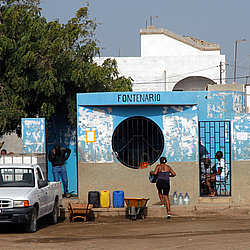Cape Verde: Cape Verde Financial Sector Profile 2012
2012/02/28
Cape Verde Finance Profile 2012
Cape Verde: Financial Sector Profile
 Cape Verde is often referred to as a success story in Sub-Saharan Africa: over the past several years, the country has achieved major economic transformation thanks to it sound homegrown reform program. Between 2000 and 2009, real GDP increased on average by over 7 percent a year, well above the average for Sub-Saharan countries and faster than most small island economies in the region.
Cape Verde is often referred to as a success story in Sub-Saharan Africa: over the past several years, the country has achieved major economic transformation thanks to it sound homegrown reform program. Between 2000 and 2009, real GDP increased on average by over 7 percent a year, well above the average for Sub-Saharan countries and faster than most small island economies in the region.
Strong economic performance was bolstered by one of the fastest growing tourism industry in the world, as well as by substantial capital inflows that allowed Cape Verde to build up national currency reserves to the current 3.5 months of imports. Inflation and real interest rates have been declining steadily.
Unemployment has been falling rapidly, and the country is on track to achieve most of the UN Millenium Development Goals – including halving its 1990 poverty level.
In 2007, Cape Verde joined the WTO and in 2008 the country graduated from Least Developed Country (LDC) to Middle Income Country (MIC) status.
Despite these positive developments, Cape Verde continues to face several challenges. The economy is highly dependent on the tourism industry, which accounts for 99 percent of foreign direct investment (FDI), funds 50 percent of the current account deficit, and is the largest sources of foreign currency. The decline in tourism receipts as a result of the financial crisis highlighted the country’s reliance on the industry and the potential adverse effects of a decline. Moreover, while substantially reduced from previous levels, public debt remains high, at 50 percent of GDP. In addition, Cape Verde continues to rely on official development assistance (ODA), which reached 8 percent of GDP in 2008.
Cape Verde’s financial system is dominated by a few large commercial banks. The national currency, the Escudo, is pegged to the Euro.
The banking system is sound and banks are highly liquid, with ratios of capital to risk-weighted assets of above 11 percent. Credit to the private sector has been growing by an average of 10 percent a year, reaching 58 percent of GDP in 2009. Non-performing loans, however, reached 8 percent of total in 2007.
The Cape Verde Stock Exchange has been revitalized; its market capitalization is now 25 percent of GDP from zero in 2005. The Central Bank has increased its issuance of paper on the domestic market, which grew from zero to USD 100 million between 2005 and 2007.
The provision of housing finance services is heavily geared towards the tourism industry and emigrants building their second homes on the island. However, bank exposure to real estate is largely through residents, with loan-to-value rations averaging 80 percent.
Nonresident deposits make a substantial contribution to banks’ deposit base, at 37 percent of total in 2007. Remittances inflows grew steadily but decelerated to 6 percent in 2008 – partly as a result of the financial crisis, but also due to new investment opportunities arising in the markets, notably shares listed on the Cape Verde Stock Exchange.
- Cape Verde News
-
- CHINA: Macau businessman wants to take companies from China to Cabo Verde
- BOTSWANA: Routes Africa forum aims to improve African air connectivity
- BOTSWANA: Economic integration is helping boost trade and investment in Africa
- BOTSWANA: Africa’s economic growth is likely to be slower in the intervening years
- BOTSWANA: Beyond Commodities: How African Multinationals Are Transforming
- CAPE VERDE: Standard & Poor’s said Cabo Verde’s reputation as one of the most stable countries in Africa
- Trending Articles
-
- AUSTRALIA: Australia taxes foreign home buyers as affordability bites
- SERBIA: China’s Xi sees Serbia as milestone on new ‘Silk Road’
- INDIA: Indian central bank chief to step down in surprise move
- CHINA: United States sees China investment talks ‘productive’ after new offers
- THAILAND: Foreign investment plummets in junta ruled Thailand
- UNITED STATES: Trump says Britain should leave EU









